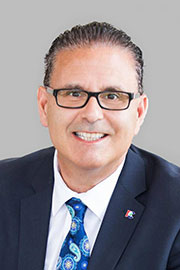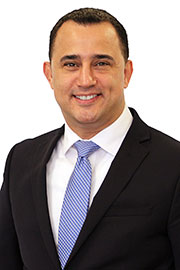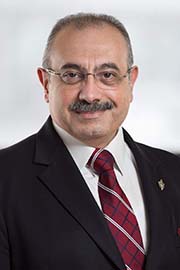- Hear!
- Rabble!
- Nov/15/22 10:20:00 a.m.
On Friday last week, the President of the Treasury Board joined me in Mississauga–Lakeshore for a tour of the construction site at Mississauga Hospital, where work is well under way on a new eight-storey parking structure with spaces for almost 1,500 vehicles. This is an important first step towards the complete reconstruction of the entire hospital. The new 24-storey facility will be almost triple the size, with almost three million square feet of space and almost 1,000 hospital beds, over 80% of which will be in private rooms. It will add over 20 new, state-of-the-art operation rooms. This will be the largest and most advanced hospital in the history of Canada. The fall economic statement yesterday reported that the RFP has closed, and it has confirmed our government is committed to this historic project.
So I want to thank the Minister of Finance for his statement yesterday—and this Minister of Finance cares about Mississauga–Lakeshore. Again, I want to thank him and the President of the Treasury Board for their support for this important project. We have been looking forward to a new, modern hospital in Mississauga for many years, and it is very exciting to see shovels in the ground.
- Hear!
- Rabble!
- Nov/15/22 10:40:00 a.m.
It is now my distinct pleasure to invite the pages to assemble for their introduction.
From the riding of Eglinton–Lawrence, Nicholas Baryliuk; from the riding of University–Rosedale, Joel Bozikovic; from the riding of Peterborough–Kawartha, Isabelle Casselman; from Timiskaming–Cochrane, Kennedy Dabner; from Glengarry–Prescott–Russell, Mabel Follis; from the riding of Essex, Kalila I’Anson; from Brampton East, Serena Joseph; from Sudbury, Ema MacAulay; from Niagara West, Camilla Moscato; from Mississauga–Malton, Yusuf Muinuddin; from the riding of Toronto–Danforth, Aiden Perritt; from Willowdale, Oriana Sethi; from the riding of Markham–Thornhill, Eric Sung; from the riding of Mississauga–Erin Mills, Hussain Umar; from the riding of Algoma–Manitoulin, Havana Rose Thibideau Bello; from the riding of Northumberland–Peterborough South, Alexandra Vanden Bosch; from the riding of Pickering–Uxbridge, Max Weatherhead; from Elgin–Middlesex–London, Scarlett Wilson; and from Sault Ste. Marie, Grace Curran.
Welcome to the Legislative Assembly.
Applause.
The final supplementary.
The next question.
- Hear!
- Rabble!
- Nov/15/22 11:30:00 a.m.
I thank my honourable colleague for the question, Speaker.
This government has always been and will always be focused on making the lives of Ontarians better, particularly when it comes to finding a home. We’ve committed every resource available to ensuring families and individuals have a place to call home and a roof over their heads. That includes making sure that every person has access to the assistance and support they need.
Speaker, I was just in Mississauga alongside my colleague from Mississauga–Streetsville for an announcement for 40 supportive housing units with an investment of $4.5 million. We’ve invested $2.25 million in Brantford to create 26 bachelor units for vulnerable people experiencing homelessness, $3 million in Guelph to create 16 units, $2.5 million in Barrie to create 14 units, $1.8 million in Windsor to create 26 units, and $1.1 million in Simcoe for 18 units.
These are just a few of the examples of how we are building 3,100 housing units. We’re making the capital investments through the Ontario Social Services Relief Fund so that—
- Hear!
- Rabble!
- Nov/15/22 11:30:00 a.m.
Mr. Speaker, in my riding of Mississauga–Erin Mills, there is a growing need for more supportive housing.
While our government has committed to supporting vulnerable and at-risk populations, the need in my riding is urgent. Many of our most vulnerable not only need a place to live, but they also require additional care and support.
Stated plainly, there is not enough housing supply. There is currently a lack of affordable housing availability that meets their specific needs, a situation which creates additional stress and pressures on those who are already facing challenges and difficulties.
Speaker, can the Associate Minister of Housing please share what our government is doing to meet the supportive housing demands in my riding?
- Hear!
- Rabble!
- Nov/15/22 4:20:00 p.m.
- Re: Bill 36
Thank you, Madam Speaker. We’re the host of the greater Toronto airport. We’re the host for everybody. That’s Mississauga–Malton. I just want to say thank you to the residents of Mississauga–Malton for giving me an opportunity so that I can talk on an important bill today.
Madam Speaker, I’m proud to rise in the House today to speak about the wonderful things that this government and all the members on this side are doing to help the people of Ontario through our fall economic statement, which is right here. To all residents of Ontario, take a look at it; read it. It’s a wonderful document. It talks about “Team Prosperity,” what your government is doing, where we are investing, and how, together, we’re going to build a better Ontario.
The fall economic statement helps Ontarians to provide financial relief by reducing taxes, raising earnings and encouraging participation in the workforce. We are making real progress to get Ontario back on track, help people find work and build Ontario’s economy for the future and the world to envy.
From day one, we stood with the workers of this province, and we have made a commitment to build an Ontario for the next generation, and that is what this is doing here, Madam Speaker. That is why we’re making critical investments to help people get better jobs with bigger paycheques and, in doing so, building a better and stronger Ontario and better and stronger communities.
I want to take a special focus on what our government is doing to help address the labour shortage in our province. It’s not a hidden secret. In the last four and a half years, we have seen the government working together with businesses, with the province and hard-working Ontarians, making sure it is economical to do business here. When you reduce the cost of doing business and increase support in increasing the revenue, what happens next? More businesses create jobs, and that is what has happened. We have seen that the number of jobs has gone up, but the number of jobs still pending and not being filled has gone up by around 380,000 people. That’s what we are doing here.
In order to get to the place where we can have those people filling these jobs, we are looking to immigration. And I know, and I noticed that we had a conversation when the Premier stood up and talked about that in the next few years we are going to get approximately 500,000 people coming and choosing Canada as their home. Typically, what happens is, they look for a good place to come, and what could be better than Ontario—something I chose on January 15, 2000. If 60% of those 500,000 come here, that’s about 300,000 people. We always welcome newcomers to our province and have wanted to make sure that Ontario remains competitive on the international stage. That is why what we are doing is celebrating their milestone.
Oh, thinking about milestones, Madam Speaker, I want to talk about my uncle and aunt: Mrs. Raj Bhupinder Kaur Cheema. She got married to my uncle Bhupinder Singh Cheema on November 14, 1964. They just celebrated their 58th wedding anniversary, so I just want to say congratulations. It takes a lot of courage and perseverance to stay together, but you did an amazing job and you raised my cousin very well. So I just wanted to say this to them.
Madam Speaker, talking about finding the skill set, I just want to quickly talk about the OINP program. Since 2020, we have people from 130 countries who have come together and over this period we have been able to support 2,200 different employers in leveraging the Ontario Immigration Nomination Program. By the end of this year, over 40,000 international skilled workers have been nominated through the OINP program, and I just want to give an example of what our government has done and how it has helped. Before our new expression-of-interest system, only 7% of the foreign worker stream were trained in jobs in construction. As we know, we want to build more homes and we want workers in the construction industry. After changing the system, we have seen the improvement in the result and actually the numbers have doubled to 14%. We will continue to work with our economy and the labour market to make these changes so that all these new immigrants who are coming and making Ontario their new home can thrive and raise their families.
We’ve talked about, through Ontario’s Plan to Build, how we are going to help the Ring of Fire, committing approximately $1 billion to support the critical legacy infrastructure, attracting $16 billion in investment by global automakers and suppliers of electrical vehicle batteries right here in Ontario and attracting $2.5 billion in investments to produce clean steel. When we do have these investments coming up, they’re actually creating jobs. To fill those jobs, we need people. I always say, in a simple single system, jobs need people, and people need jobs. When we work together, we give them a hand up, and we make sure the economy grows well. That is why we have seen over many years—the last few years, especially—the revenue growing year by year. Thanks to each and every hard-working Ontarian for contributing.
We actually had a bill, our Working for Workers Act. We want to make sure that new immigrants who are making this country, and Ontario especially, their new home have a job in their own field. That is why we made sure that we brought in the changes to the foreign credentials, so that they don’t have to wait for their licence and they can go ahead and as soon as they arrive they can start working towards their professional licence and can work in their own field.
By an estimate, we’ve noticed that if people work in their field, which, in fact—the last data, which we had in 2016: Only 25% of the people were working in their own field. What that means is, if they were working in their field—for an example, if you take somebody who is an undergraduate in engineering, like me, I was working at about $40,000. If I had had a licence as a professional engineer, the minimum entry salary would have been $70,000 to $75,000. The differential between the two, if you really look at that—you’re basically adding the revenue to the businesses, you are adding the revenue to the families, you’re adding the revenue to the government as well. If you calculate the whole thing, the differential is between $15 billion and $20 billion. And we can collect and use that money to service Ontarians, and that’s what we’re doing now.
For instance, we are providing an additional $40 million in 2023 in new funding in the Skills Development Fund to support our priority infrastructure fund and our youth employment training. Along with that, we’ve provided $4.8 million over two years for dual credits to enhance pathways for high school students like my daughter, who is in high school, so they can go into the skilled trades and early childhood education. Why do we need this? Well, Madam Speaker, we all know we are going to $10 child care, and to do that, we need people who can support that child care education, and we need to make sure our youth are ready and supported.
And we helped more than 52,000 people find a path to employment via Ontario’s integrated employment services system, which began in 2020. Colleagues, if you really look at this, 52,000 people getting a job means 52,000 fewer cheques from the government. This means 52,000 more people paying to the government. That’s what we’re doing. With a special focus on the skilled trades, we are continuing the efforts to make sure that everyone who can work and who wants to work is able to work. That is why we’re making sure we’re making the investments in training more than ever before.
Madam Speaker, we always hear about workers: how we’re supporting the workers, how we’re supporting the minimum wages. One of the things we did was to increase the minimum wage to $15.50, including the workers who are in the hospitality business. At the time when we increased from $12.50 to $15, the raise was about 19%, something which we believe that our workers need our help, and we are always there to help them. That’s how we added 11,700 health care workers, including nurses and personal support workers, as well as 800 internationally educated nurses who have become licensed as nurses in Ontario through government-funded programs.
The statement also mentions our continuous support to the small businesses. Madam Speaker, in 2021 alone, small businesses made up 98.1% of all employer businesses in Canada. They employ 63.8% of the total labour force. Given the fact that the majority of small businesses are concentrated in Ontario, supporting them in offsetting their tax burden is a direct contribution to creating and sustaining job opportunities in Ontario. Under our new program, thousands of businesses will now qualify for the small business corporate tax rate, allowing them to save tens of thousands in taxable income. What do they do with that money? They invest back into their business. By creating more jobs, they bring more people on board and help many more Ontarians to get financial independence.
Besides providing over $675 million in Ontario income tax relief over three years by temporarily allowing eligible businesses to immediately expense up to $1.5 million per year for certain capital investments, the statement also proposes to extend the phase-out range for the small business corporate tax between $10 million and $15 million of taxable capital.
When we look at these things, all these small steps add up to bring bigger results, and that is what we’ve seen in the past few years. We have seen the increase in revenue. Every paycheque not collected is a missed opportunity for a worker and their family to start a better life. That is why we extended the programs that made a real impact on thousands of lives.
For example, we are doubling the Guaranteed Annual Income System—GAINS—payment throughout 2023 and providing more than $40 billion in the next 10 years to improve and increase the space in hospitals and build new health care facilities.
As part of the plan to keep costs down, we are helping and making sure that millions of drivers will be relieved from gasoline tax till 2024. We’re making sure that the 5.7-cents-per-litre discount that was set to expire at the end of 2022 is extended until December 31, 2023.
Madam Speaker, we’ve talked about ODSP recipients in the past, how we are able to help them and support them. Through this statement, we’re going further and making sure that a recipient is allowed to net $200 in monthly pay before their provincial payments are reduced, raising their earnings threshold to $1,000 per month, while also increasing the percentage of support money that’s clawed back. We’re also increasing ODSP core allowances and the maximum monthly amount for assistance for children with severe disabilities by 5%. This way, over 25,000 ODSP recipients will be encouraged to participate in the workforce, which will help the province address the labour shortage and give them financial independence.
Madam Speaker, I just want to quickly talk about our Skills Development Fund. To date, with the $560-million investment that we made in the Skills Development Fund, we are proud to say that, to date, almost over 400,000 people around the province have taken the next step in their careers. That’s what we see when you help workers. When the government comes together and supports workers, workers come together and support our province of Ontario.
We have seen the high uptake and interest from stakeholders and the continued success of the program. I just want to quickly talk about two things in this program. We have seen in the past that about 10% of our Canadian population has some sort of criminal record; some mistake made and already paid back. They’ve already taken steps to rectify it, but the stigma stays with the person. What our government is doing through the SDF, we’re giving a hand up to those people and making sure they have a second career, a second chance to prove themselves. And we have seen the results of this: Prisha, for example, from Etobicoke, who is actually working into a skilled trade and building an amazing career. That’s something we want to continue.
Given the success, we are looking to invest $20 million in 2022-23 to enhance our SDF, with a focus on supporting priority infrastructure projects by hiring, training and retaining those workers, including apprenticeships. The intended outcome of this initiative is to ensure that there is sufficient skilled labour and training resources to meet labour demands from the significant capital investments made across the province.
In October 2022 alone, we have seen the results because of all the efforts we all put together: government and our wonderful workers and Ontarians. We have seen Ontario lead the country in job growth by creating over 42,000 new jobs. As the Minister of Finance said recently, we have also added, as I said earlier, over 11,700 health care workers to Ontario, including nurses and personal support workers to our health care system.
Madam Speaker, on top of our skills development program, we are investing hundreds of millions of dollars in innovative training programs to help people looking for work find good jobs close to home. For an example, our government’s Better Jobs Ontario program is making sure that it’s providing up to $28,000 available for short-duration training programs.
I’ll give you a small example. Before COVID hit, we had over 50 million visitors coming to the greater Toronto airport, and there were approximately between 250 and 300 taxi drivers supporting those visitors. But when the numbers had gone down to about 10 million, there was not a need for those taxi drivers—the people who always worked and made sure they helped those visitors so that they can reach their homes on time or can have a better experience in our province. But because of COVID, they lost their jobs, and that’s where the Better Jobs Ontario program comes in handy.
If you are in a profession where you can’t find a job or you believe the number of jobs has gone down, you can always take a short-duration course and pick up a career in in-demand jobs. Through this, we were able to help many of the residents in Ontario. We’re also making employment services easier and more convenient than ever, so that we are able to help thousands of people get what they need to get into the workforce.
No matter how or where you work, we believe more workers in Ontario should have access to benefits such as health and dental plans, and that is why we are working towards a portable benefit program so that we can help those vulnerable employees, workers, right here in Ontario.
To do this, we actually have a portable benefits advisory panel, which was established in March 2022, to advise the government on the viability, design and implementation of a portable benefits program for Ontario. The panel began consulting with the public and key stakeholders in September 2022, and will provide their final report and recommendations to the government in 2023. This is another way we are helping our workers in the province of Ontario.
Madam Speaker, we are making real progress and changing and supporting the lives of millions of Ontarians, including Ontario workers who stood up during the pandemic and supported our Ontario. We just want to take a moment and thank each and every worker for all your hard work and making sure that we can stand back on our feet, stronger than before COVID. So thank you for that, and as we continue in our mission, we will continue to work hard to make sure that families are at the centre of our focus.
Stronger families create stronger communities, and that’s why our government is making critical investments to help families and build up Ontario for the future. I commend the minister and his PAs for doing an incredible job and making sure that Ontario is the best place in the world to live, work and raise a family.
Madam Speaker, I just want to take a moment and want to commend the whole caucus for coming together, working together so that we can achieve this great success in our province. I look forward to all of you—let’s continue to work together and support our great province. Let’s support this bill.
- Hear!
- Rabble!
- Nov/15/22 4:50:00 p.m.
- Re: Bill 36
Madam Speaker, through you to the member for Mississauga–Malton: You often talk about your journey here, from India to Canada, and how proud you are that you were able to build a career, raise a son and a daughter, and take advantage of the opportunities that Ontario provides.
I would like you to share with the Legislature this afternoon what our government is doing, the measures we are putting in place, so that other new Canadians can also pursue a career and perhaps even realize the dream of home ownership.
- Hear!
- Rabble!
- Nov/15/22 4:50:00 p.m.
- Re: Bill 36
Speaker, there are so many aspects to Ontario’s Plan to Build. I want to therefore ask the member from Mississauga–Malton if he could explain how this proposed legislation will support the government’s efforts to address the labour shortage in Ontario, particularly the shortage in skilled trades, and in reference to the Skills Development Fund.
- Hear!
- Rabble!








